“Work with your AI technician or reproductive consultant to find out which protocol fits the budget. We can help you decide which protocol will work the best depending on the time and labor resources available,” says Stan Lock, Genex area sales manager.
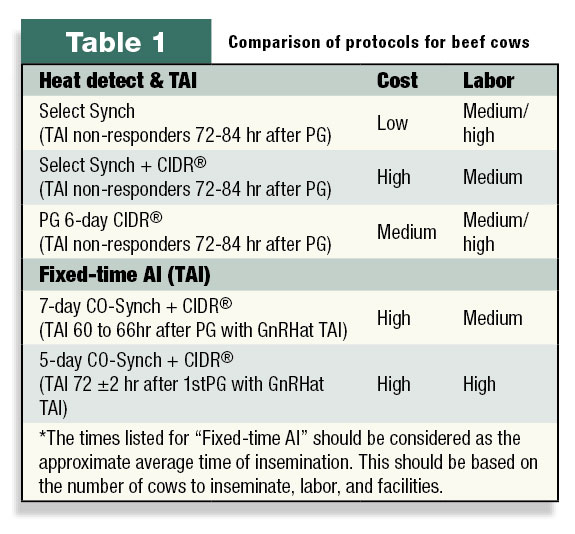
Operators must make a commitment to estrus synchronization programs. Deciding which protocol begins and ends with dedication.
“There are a wide variety of estrus synchronization programs. Choosing which one works for your operation is very important. These protocols take a commitment ranging from a few days to a few weeks. Some simple protocols, which are less costly, require more labor in heat checking. The more costly synchronization programs are usually more successful with timed AI,” says Dr. Joe Paschal, Texas AgriLife Extension, Corpus Christi, Texas.
Each protocol varies a little. Successful synchronization programs will all have certain things in common. Most AI candidates start with having some basic tools of management in place. This should ready the operation for the next step.
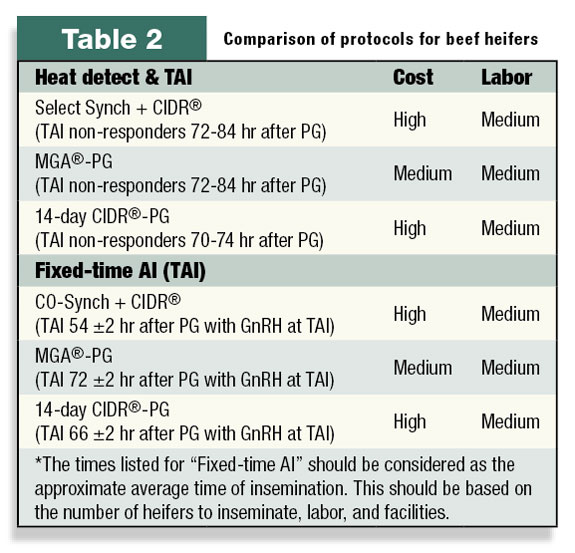 “Make sure herd health and nutrition programs are up to date. Vaccinations for reproductive diseases and cows are in a body condition score (BCS) of at least 5,” Paschal says. “Decide why you are using AI and what you expect in terms of results.”
“Make sure herd health and nutrition programs are up to date. Vaccinations for reproductive diseases and cows are in a body condition score (BCS) of at least 5,” Paschal says. “Decide why you are using AI and what you expect in terms of results.”
“Candidates for successful AI programs will have a good herd health and nutrition program in place. These are two things that need to occur in the proper progression for the targeted breeding date,” Lock says. “Body condition score (BCS) cattle prior to implementing any synchronization program. Cows should be at least a BCS 5+ to 6 and must be enough days post-partum to breed. Heifers should be 60 percent of mature body weight.”
Each synchronization protocol comes with its own set of rules. Producers need to evaluate the availability of resources to decide which code of behavior will best fit the operation.
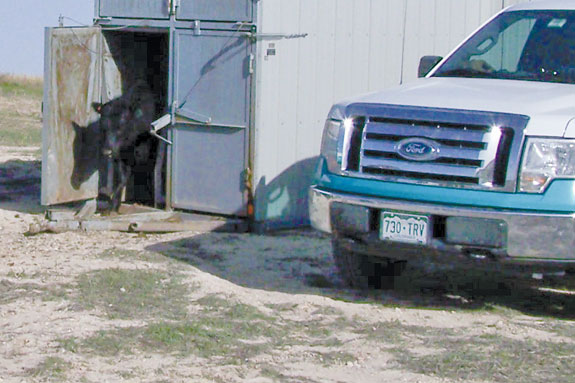
“If an operation is limited on labor, then a timed AI protocol works really well. Timed AI can be done in one day with comparable results to synchronization and heat detection. With timed AI, drug costs are a little higher, but the tradeoff is labor costs are less,” Lock says.
“Fifty-five to 65 percent is a logical expectation for conception rate. A lot of our clients like it better when I explain they could get 55 to 65 percent of their cows pregnant on the first day of breeding season.”
“Some estrus synchronization programs are more expensive in terms of product. Others, in terms of labor needed to successfully complete the process. Decide which protocol fits your needs and skills,” Paschal says. “Decide who is going to do the heat- checking and the AI. Heat-checking is the most important part of AI, unless you are using timed AI. Costs are variable with each program because some require more time and more trips through the chute.”
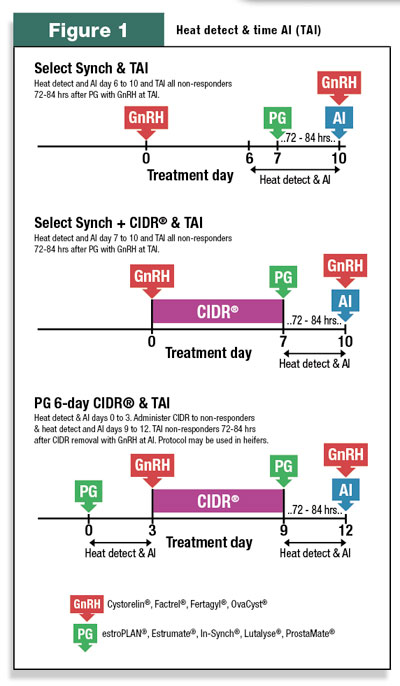
Producers usually look to AI as a means of genetic improvement. However, for some, the real benefit comes through the synchronization process. Cattle can be put on a time clock from this point to help daily management.
“Breeding is done over a shorter period of time. This makes the resulting calving in a shorter period. These are labor-intense periods that can be more accurately managed through synchronization,” Paschal says. “Shorter calving and breeding periods allow for better nutritional and health management.
Producers can expect more uniform and usually heavier calves that will be marketed at the same time. For programs interested in saving replacements, heifers will develop at about the same rate and reach puberty in a narrower range of time.”
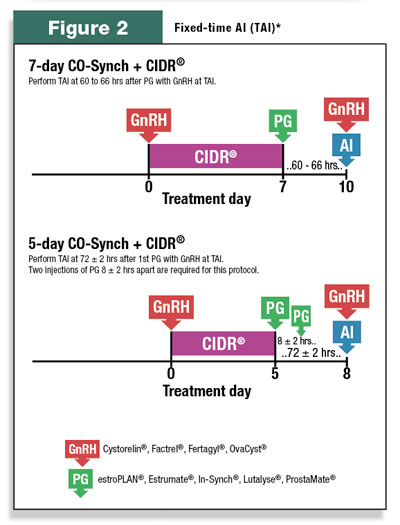
“Synchronization helps tighten calving season. Every year we synchronize the same group of cows, we’re going to get a little more concentrated. Once cattle are concentrated, it makes other management easier to administer. Producers can give more timely vaccinations and apply nutrition when the cows’ needs are the highest,” Lock says.
“For most, a realistic goal the first year is condensing the calving season down to 45 days. Try to get 60 percent bred on the first day of breeding season and use cleanup bulls to settle 80 percent of the remaining cows by day 30.”
Pencils have sharpened for most concerned with production costs. Genetic improvement and more efficient management are goals of most operations. The real cost of AI could be the time and labor invested.
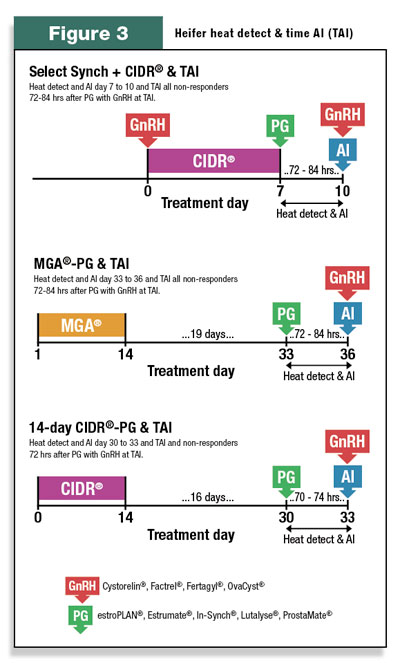
“Calves born from a successful timed AI program are 10 days older and gain 2.5 pounds per day. Most have more than paid for the cost of synchronization because of extra weight without the advanced genetics figured into that equation,” Lock says. “There are a lot of benefits to synchronization: tighter calving intervals, heavier calves and better replacements. Producers go from getting cows bred to a total reproductive program.”
“Synchronization and AI pay in terms of a more uniform and heavier calf crop. Semen, labor and product costs are less per cow bred than purchasing genetically similar bulls. Initial investment and maintenance costs (1.5 to 2 times the cost of maintaining cows) for these genetically superior sires are cost-prohibitive for most operations,”
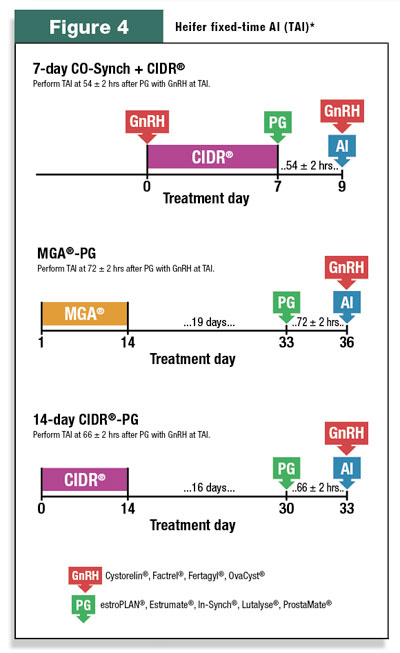
Paschal says. “‘Genetically superior’ are the key words. It probably won’t pay to use average bulls in an AI program.”
Most cattlemen are always looking for a place to start implementing new management techniques. According to Lock, virgin heifers seem to be a logical place for most producers to start an AI program. “Heifers are a lot easier to handle because they don’t have a calf. They are usually in the same management group so it’s not as taxing on the labor force,” he stated.
Pre-planning is key to AI and synchronization programs. Decide early which group, what protocol and which sire fits your production goals.
“Decide when you are going to begin and have everything together at least a week in advance,” Paschal says. “Some of the synchronization drugs require a prescription and others need to be ordered. They are not usually carried at the local feed store or even by your veterinarian.”
“Some of these reproductive drugs require a prescription so it is important that producers work with their local veterinarian,” Lock says. “Try to have everything in place at least 30 days before you start the synchronization protocol. Some bulls will have a waiting list due to semen availability, another reason it is important to pre-plan the AI program. Work with your technician to help finalize details.”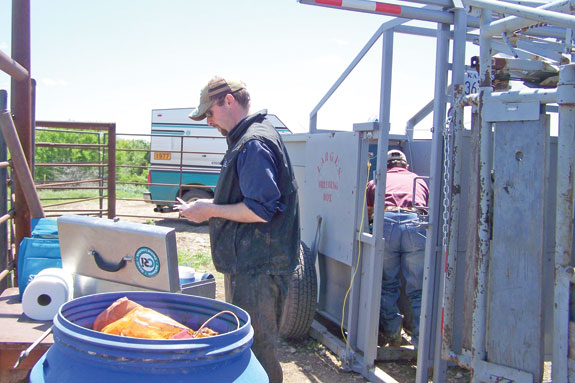
PHOTOS
Top: Pre-planning the AI and synchronization process is a must. Semen, AI equipment and synchronization drugs are specialty products. Work with your veterinarian and AI technician to make sure you have these products on hand prior to the synchronization process. Sometimes the demand for popular AI sires comes with a waiting period.
Middle: Large portable breeding barns back up to any chute or alley. This helps extend working facilities for the AI technician during the actual insemination process. Typically, technicians can breed 60 to 80 head through one of these barns.
Bottom: Insemination takes qualified technicians to get the job done. This is the last step in the synchronization process, whether producers choose to check heats or timed AI. AI with genetically superior sires should help producers reach end-product goals in a more timely manner. Photos courtesy of Genex.






